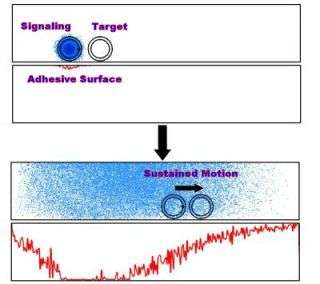Scientists report that chemical signaling between microcapsules can initiate the capsules' movement, a finding that could assist nanomachines in drug delivery as well as a host of other applications. Courtesy of O. Berk Usta
In a finding that could provide controlled motion in futuristic nanomachines used for drug delivery, fuel cells, and other applications, researchers in Pennsylvania report that chemical signaling between synthetic microcapsules can trigger and direct movement of these capsules. Their study is scheduled for the currrent isssue of ACS Nano.
Researchers theorize that synthetic capsules can communicate with each other by physically shuffling chemical signals from capsule to capsule, much like passing water through a fireman’s bucket brigade. Scientists recently suggested that this same signaling process also appears capable of sending cues to direct cell movement.
In the new study, Anna C. Balazs and colleagues used computer models to simulate the chemical signaling.
They modeled a porous polymer microcapsule filled with nanonparticles to imitate a biological cell. When placed next to an empty capsule, nanoparticles from the filled capsule initiated the motion of the empty capsule, which in turn caused the movement of the filled “signaling” capsule.
The same locomotion process could be engineered into futuristic nanomachines to help direct their movement through the body or through fuel cells, the researchers suggest.
Source: ACS























